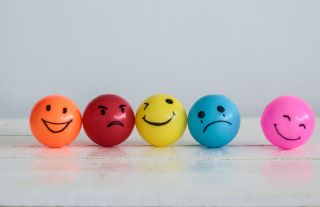Emotion Regulation
The Case for Big Feelings
How the suppression of emotions hurts us all.
Posted July 14, 2023 Reviewed by Ray Parker
Key points
- Our culture misunderstands emotion, teaching us that feelings are a sign of weakness or mental instability.
- In reality, emotions are a near-constant part of life and one of the primary ways humans take in information.
- Emotions and thoughts are not at odds; they work together to help us make sense of the world.

As a therapist, I often work with clients who have survived incredible adversity. Many are still in crisis when they come to me, dealing daily with things like disability, discrimination, and ongoing abuse.
I don’t think of myself as naive, but I never cease to be amazed by what a person can overcome. As humans, we can be shockingly tenacious when we need to be, and few professions make one more aware of that. What does surprise me is how often clients see their response to the hardships they’ve lived through (read: their feelings) as the problem. They don’t say this explicitly, but in so many words:
- “If I wasn’t so sad, I could get back to work.”
- “I’m furious with my boyfriend, but I have no reason to be.”
- “I’m always overreacting. I don’t know why I care so much.”
Too Sensitive
In some ways, I get why they hold this view. Many of us were told from a young age that we’re "too sensitive:" We feel the wrong things, in the wrong amount, at the wrong time. If none of the adults around us were emotionally expressive, we had no choice but to internalize this message and believe that the problem was us.
It follows, then, that many think the goal of therapy is to eliminate bad or intense feelings entirely. This tracks with the Western model of medicine, where the symptoms of a condition are to be masked without much curiosity about their cause. Feelings aren’t symptoms of ill health, though. They aren’t even a divergence from the norm the way a fever or a headache would be, they are the norm.
Emotional states aren’t limited to the rising and falling of strong negative feelings, as the colloquial understanding implies. They’re a near-constant feature of our experience. Somehow, we’ve come to regard emotion as a suspect: An occasional obstruction to reason and clear-thinking that we should work to avoid. But research has shown that humans are feeling at least one emotion roughly 90 percent of the time. So if we think feelings in and of themselves cloud our judgment, we should be prepared to be in a cloudy state for most of our lives.
Emotions and Thoughts
The idea that it’s even possible to separate feelings from thoughts is half-baked. Ideas and emotions are intertwined. They inform and reinforce each other. The systems of thinking and feeling work together to make sense of our endlessly shifting environment. Both take place in our bodies.
And while we may think of thoughts as more abstract or conceptual, they actually tend to arise in response to emotion. They are both bound by our physicality and therefore our limited perspective. Sure, emotions can lead us astray at times, but thoughts are just as likely to be biased or simply random. If you’ve ever just sat and observed your train of thought, you know how incoherent thoughts can be.
Cultural Bias
We are profoundly emotional creatures, and this isn’t necessarily at odds with our ability to reason. The sentiment of anti-emotionality that permeates our culture is rooted in a misunderstanding, an assumption that we have logical thoughts and illogical feelings. While this is far from the case, this misconception even pervades the field of mental health, where many traditional models of treatment train therapists to regard strong emotions as a red flag of sorts.
Old-school clinicians likely wouldn’t state a disdain for emotion directly, but much of the attitude they’ve been encouraged to embody is one of stoicism, placidity, and calm at all costs. The example this demeanor provides to clients inadvertently reinforces the idea that mental health is a matter of toning down our emotions so that thoughts alone can guide us. For those whose emotions are central to their healing, this method can both delay the process and perpetuate shame.
Because we’re taught that emotions are irrational, untrustworthy, and generally a sign of weakness, we think we’re doing right by ourselves when we ignore them. We think that by dismissing the knot in our stomach, we’re being mature. We think that by focusing exclusively on logic, we’ll make better choices.
But really, we also need access to our feelings to make good decisions. Our feelings, as much as our thoughts, help us determine what matters as well as what’s right and wrong for us. Much of the work of therapy lies in helping clients return to feelings they’ve been cut off from.
Key to Clarity
In doing so, people who’ve felt stuck on a choice, sometimes for decades, may instantly know what to do. Whether it’s a woman who’s denied that her marriage is unhealthy, someone who chose a profession they’re not suited for, or a parent whose gay child has them conflicted about their beliefs, feelings are often the key to clarity.
The belief that a person is either being logical or emotional is scientifically baseless, but that’s not really my problem with it. The social implications of this idea are dangerous. When we conflate emotional expression with an absence of rational thought, we assume that anyone who’s openly hurting is being unreasonable.
This means that we feel free to discredit the point of view of those who are most overtly struggling, a strategy we see playing out far too often on the political stage. This belief also causes us to position those who are having the easiest time as more trustworthy and sane.
But just because someone’s needs are being met doesn’t mean they’re rational or unbiased. Likewise, the fact that someone is grieving, starving, or terrified doesn’t mean they’re not making perfect sense. There are situations in which intense emotions like despair or rage are the most reasonable response.
When we don’t trust our feelings, it becomes difficult to navigate our experiences. We may endlessly try to weigh the pros and cons without an inner compass telling us which way to go. We start to regard each other with skepticism and lack the empathy needed to connect well.
Instead of saying, "Wait until you’re thinking straight," we could try saying, "Wait until you understand your thoughts and feelings." That’s actually good advice. It does mean, however, that we’ll have to get better at feeling things.
From A Pity Party is Still a Party by Chelsea Harvey-Garner. Copyright 2023 by Chelsea Harvey-Garner. Published by Harper Wave. Used by permission of the publisher. All rights reserved.
References
A. Bechara, H. Damasio, A. R. Damasio, and G. P. Lee, "Different Contributions of the Human Amygdala and Ventromedial Prefrontal Cortex to Decision-Making," The Journal of Neuroscience: The Official Journal of the Society for Neuroscience 19, no. 13 (1999), 5473-81, https:/doi.org/10.1523/JNEUROSCI.19-13-05473.1999.
C. E. Izard, "Emotion Theory and Research: Highlights, Unanswered Questions, and Emerging Issues, "Annual Review of Psychology 60 (2009): 1-25, https://doi.org/10.1146/annurev.psych.60.110707.163539.
D. Trampe, J. Quoidbach, and M. Taquet, "Emotions in Everyday Life," PLOS One 10, no. 12 (2015), https://doi.org/10.1371/journalpone.0145450.
M. Solms, "Thinking and Feeling: What's the Difference?" Future Learn (blog), October 2015, https://www.futurelearn.com/info/blog/thinking-and-feeling-whats-the-di….




